Fantastic feats Teach article
Entertain your audiences with these tricky feats, which showcase Newton’s laws of motion in action.

This article is the first in a series of light-hearted challenges that are fun to do and also demonstrate some intriguing scientific principles – once you know how to solve them. We hope that readers will be tempted to share their own ‘fantastic feats’, which we will publish in future issues.
Centuries ago, Isaac Newton set out three scientific principles known as the laws of motion. Here we describe some demonstrations involving these principles and set out the challenges. To solve them, think about where the forces are in each situation, and which of Newton’s laws apply.
See if you can work out how to succeed. If not, you’ll find the solutions below.
Feat 1: money grab
The task is to balance a bottle upside down on top of a banknote, and then remove the note without touching the bottle or knocking it over. You can set this up as a challenge to see who can win the banknote, or just perform it to amaze your audience.
This feat needs steady hands and some nerve, especially if you are using a glass bottle. It’s best to practice with a plastic bottle first: once you’ve mastered the feat with this, you can move on to the harder stuff – or stick with the practice version, which is still guaranteed to impress.
Materials
- A clean, newish banknote
- One plastic soft drink bottle (about 500 ml capacity) – if possible, one with a small, very smooth and perfectly flat cap; or
- One glass bottle (about 500 ml capacity) – a more daring alternative
- A table with a smooth surface
Procedure
- Half fill the plastic bottle with water and screw the top on well.
- Make sure that the bottle cap (or bottle neck, if you are using an empty glass bottle) is perfectly dry. Any dampness will significantly increase the friction with the banknote, making the feat almost impossible to perform. (This is a sure way to win the banknote if you set the task up as a challenge: simply dry the neck when it comes to your turn.)
- Place the banknote on the table, and place the upturned bottle on top of the note, neck downwards (figure 1).
- Now try to remove the banknote from under the bottle without knocking it over – or challenge someone else to do this. Hint: think about the forces acting on the bottle, and how to minimise them.
- Once you can do this with the plastic bottle, perhaps try it with the glass bottle – if you dare. (This is heavy enough, so no need to add any water.)

Image courtesy of David Featonby
Trickier tricks
Once you’ve achieved the banknote and bottle feat, you can try something harder. Can you remove the banknote from between two bottles: an upturned bottle balanced on an upright one (figure 2)? This is a lot more difficult, but it can be done.

Image courtesy of David Featonby
If you succeed at this, perhaps you’ll want to try the ultimate challenge where keeping tableware upright is needed: the classic tablecloth trick (figure 3).
In this challenge, it’s even more spectacular to onlookers if the cup contains coffee and the bottle some liquid – and in fact, this should make the trick slightly easier: can you think why?
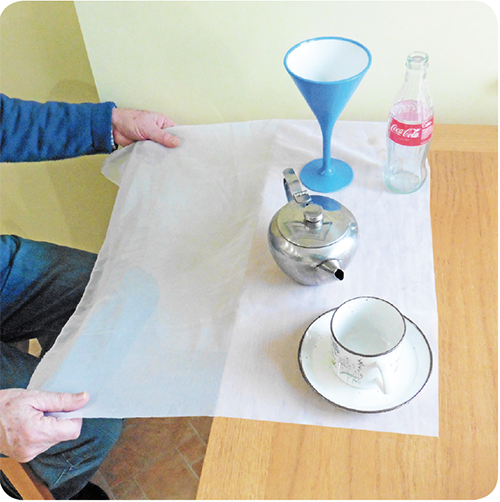
Image courtesy of David Featonby
Feat 2: drop catch
In this next feat, we show how understanding Newton’s equations can again help you to keep things from crashing to the floor. This time, it’s a slightly counter-intuitive way to catch a falling rod.
This feat is also a useful follow-up to the classic reaction-time experiment in which students catch a ruler dropped vertically to determine their reaction time (Thibault et al., 2017).
Materials
- One rod, about 50 cm long and 1–2 cm in diameter, not too heavy (wooden dowelling is ideal)
- Two people – one to drop the rod, one to catch it
Procedure
- One person holds the rod just below shoulder height.
- The other person (the catcher) must then position his or her hands about 20 cm above the rod (figure 4).
- The person holding the rod then drops it without warning, while the catcher tries to grab it. Can they get it before it hits the ground?
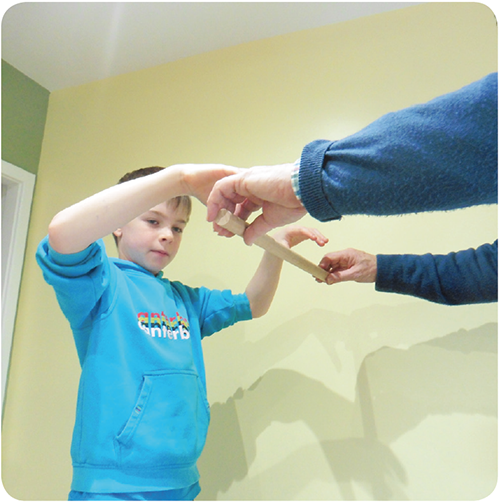
Image courtesy of David Featonby
Invitation to readers
Do you have a science trick that you could share with others across Europe? If so, please let us know!
Solutions
How successful were you? See below for some helpful hints and an explanation of how the tricks work.
Feat 1: money grab
- To perform the feat, first pull the banknote very gently towards the edge of the table, so the bottle moves with it. You need to do this because it is easiest to move the banknote from under the bottle at the table’s edge.
- Then, hold the banknote outwards away from the table edge and slightly below the table surface, as shown in figure 1.
- Now the tricky bit: you need to pull the banknote away from the bottle very sharply and with a downwards motion, so as not to lift the bottle. The best way to do this is with something like a karate chop: with your free hand, strike the note downwards, keeping a hold of the note with the other hand. This should remove the banknote easily, leaving the bottle standing upright.
- An alternative method is to roll up the banknote so that centre of the roll is in contact with the bottle (figure 2).
- Then, continue rolling up the note very gently, so that the rolled-up note pushes the bottle very slowly off the rest of the note.
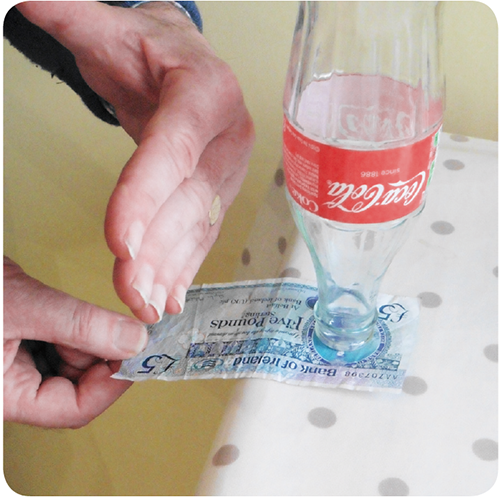
Image courtesy of David Featonby

Image courtesy of David Featonby
This feat is of course just a variation of the old tablecloth trick, where a magician astonishes the audience by removing a tablecloth from a table fully laden with fragile china, teapots, milk jugs and so on. As with the banknote, this is achieved by pulling the cloth sharply down over the edge of the table.
So why do these tricks work? The change of position of a stationary object depends upon the impulse that it receives, as described by the famous Newtonian equation:
F = ma
where F is the force, m is the object’s mass and a is the acceleration caused by the force.
Here, we want there to be as little change as possible in the stationary object’s position, which means that the difference between its initial velocity, u (which is zero), and the final velocity, v, should be as small as possible.
We know that:
a = (v – u)/t
where t = time.
So:
F = m(v – u)/t
or
Ft = m(v – u)
For the change in the stationary object (v – u) to be as small as possible, either the force (F) or the time (t) needs to be very small – or preferably both.
In the karate chop method, the time that the force is applied is very short. Ensuring the bottle rim or top is very smooth also helps to keep the force to a minimum. In the rolling-up method, the force is so small that it does not supply enough turning effect to topple the bottle.
Both methods can also be applied to a full-sized wine bottle. Which of the two sizes of bottle do you think will prove to be most difficult to keep upright?
If you think the bigger bottle is more difficult, you would be wrong. Look again at the equation
Ft = m (v – u)
We can see that, for the same force and time, a larger mass will mean a smaller change in the bottle’s position – so the larger bottle is less likely to topple.
Trickier tricks: two bottles and a banknote
It is much more difficult to remove the banknote from between the two bottles, because the tops of the bottles – which are in contact with each other through the note – are likely to be more uneven than the table in the single-bottle version.
However, if the bottles are exactly lined up, a sharp downwards chop will again remove the note, leaving the two bottles standing upright (figure 3).
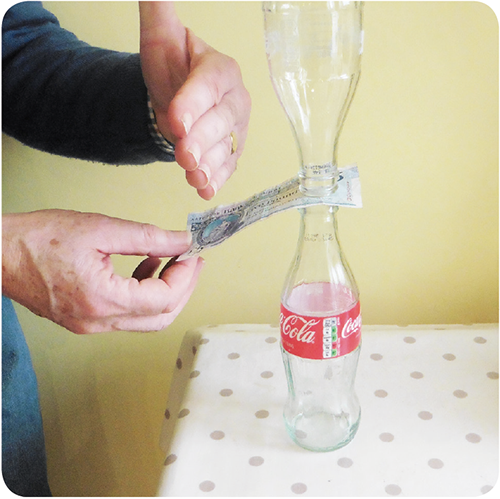
Image courtesy of David Featonby
Trickier tricks: the tablecloth trick
This is another example of the appliance of Newtonian science to tableware. For this trick to work, you need to make sure that the cloth is completely smooth at the edges and does not have a raised hem; and – as with the banknote trick – use a short, sharp pull (figure 4). Find a silky cloth for better slip (less friction, so the force F is reduced), and check that the base of anything on the table is smooth rather than rough.
Adding some liquid to the teapot and the bottle makes the trick easier to perform, because (as with the larger bottle, above), increasing the mass of an object by filling it with liquid reduces the effect of any forces on it, so it will accelerate less (and therefore move less) in response to a force.
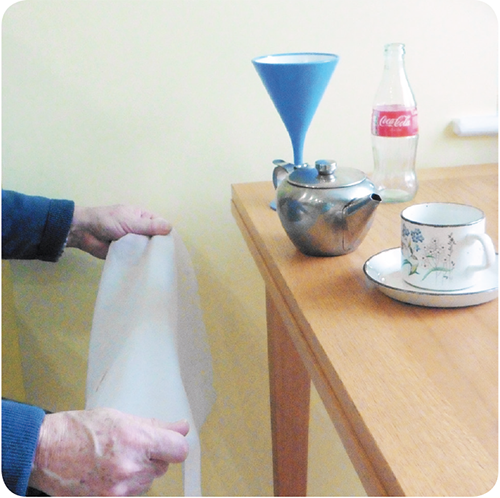
Image courtesy of David Featonby
Feat 2: drop catch
In this feat you need to work out how to make the best use of the small amount of time available for catching the rod. This time, it’s the Newtonian idea of how gravity makes falling objects accelerate that provides the clue.
The equation for this is:
d = ½at2
where d is the distance of fall, and a is the acceleration due to gravity (9.81 m/s2).
If – as most people do – you try to snatch the rod immediately after it’s dropped, you’ll find that by the time you have reacted to seeing the rod fall, it will have dropped below your hands and out of reach, and it will then be falling too fast to follow.
We can calculate the time you have to catch the rod high up (say within 50 cm of its starting point) thus:
t2 = 2d/a
= 2 x 0.5/9.81
So t = √(1/9.81)
= 0.32 s
Instead, the trick is to aim to catch the rod much lower down, just before it reaches the floor. This gives you more time to get your hands in position.
So if you try to catch the rod after it has fallen 1.5 m, the time-to-catch calculation becomes:
t2 = 2 x 1.5/9.81
So t = √(3/9.81)
= 0.55 s
This may not seem much more than the high-up time, but remember that you need some time to react, which is the same in each case – and roughly around 300 milliseconds for the average person. This means that, for the high-up catch, you have only 0.02 seconds (0.32 – 0.3 s) to move your hands 0.5 m – meaning your hands have to travel at a daunting average speed of 25 m/s.
However, if you go for the low catch, your hands have 0.25 seconds (0.55 – 0.3 s) to travel 1.5 m, allowing a more feasible 6 m/s – far less than the speed needed for the high-up catch.
So immediately after the rod is released, quickly move your hands right down as fast as possible, bending your knees at the same time. In this way, you should have enough time to catch up with the falling rod – and then, with luck, grab it.
References
- For an account of the ruler-drop reaction time experiment, see the online materials for:
- Thibault E, Biedermann K, Watt S (2017) Cans with a kick: the science of energy drinks. Science in School 39: 48-54.
Resources
Review
This article outlines some fun demonstrations using the familiar principles described by the famous scientist Isaac Newton. As well as being suitable for physics lessons, the experiments provide links to mathematics and history.
Possible questions include:
- What are the equations of Newtonian mechanics?
- How can they be applied to dynamic processes?
- What is the relationship between mass and weight?
- What is the relationship between velocity (v), acceleration (a) and time (t)?
- What are some applications of Newton’s laws?
Gerd Vogt, Higher Secondary School for Environment and Economics, Austria





